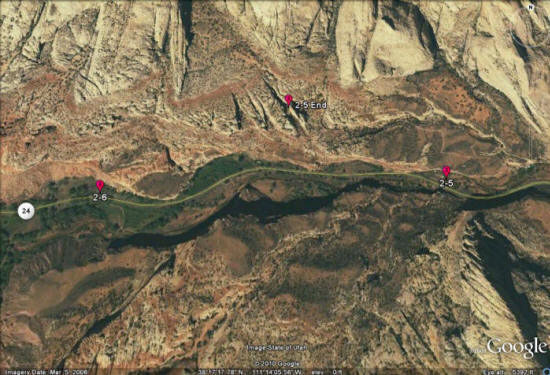Day 2, Stop 6
Petroglyphs
GPS Location:
38o 17.284' N
111o 14.538' W
Ages:
Lower Jurassic
Rock Units:
Wingate Sandstone
Features Present:
Remarkable cultural features also occur in Capitol Reef National Park. The park also has a long history of human habitation. Modern indicators of habitation include the orchards and barns of the historic Fruita district, but just nearby are indicators of much older civilizations. In the Fremont River Valley, just across Hwy 24 from some of the former orchards, are petroglyphs attributed to the Fremont Indians who occupied the area from 700 CE to 1300 CE (Mathis 2000. These petroglyphs have been carved into the desert varnish of the lowermost part of the Wingate Sandstone, just above the contact with the Chinle Formation.
In most parts of the park, the Wingate Sandstone comprises inaccessible, tall cliffs. The petroglyph stop is one of the few places to get up close to the Wingate where it shows some the large cross stratification common to eolian systems.
Depositional Environment:
Eolian



Figures 1-2: Petroglyphs on the Wingate Sandstone are attributed to the Fremont Indians who occupied the Fremont River Valley from 700 CE to 1300 CE (Mathis, 2000).

Figure 3: More petroglyphs attributed to the Fremont Indians.

Figure 4: On close inspection, the Wingate Sandstone shows large-scale eolian cross beds similar to the Navajo Sandstone.


Figure 6: Desert varnish gives the red to brown to black appearance of many outcrops in the desert southwest. Desert varnish is primarily made of iron and manganese oxides. It is only presenton outcrop faces that have been exposed for a long periods of time. Fresh rocks faces are free of the desert varnish, and typically have a vertically streaked appearance where water runs down the face of the outcrop.
